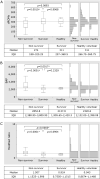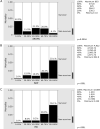Balance of the prooxidant and antioxidant system is associated with mortality in critically ill patients
- PMID: 36936878
- PMCID: PMC10017322
- DOI: 10.3164/jcbn.22-79
Balance of the prooxidant and antioxidant system is associated with mortality in critically ill patients
Abstract
It is well known that oxidative stress causes certain diseases and organ damage. However, roles of oxidative stress in the acute phase of critical patients remain to be elucidated. This study aimed to investigate the balance of oxidative and antioxidative system and to clarify the association between oxidative stress and mortality in critically ill patients. This cohort study enrolled 247 patients transported to our emergency department by ambulance. Blood was drawn on hospital arrival, and serum derivatives of reactive oxidant metabolites (dROMs, oxidative index) and biological antioxidant potential (BAP, antioxidative index) were measured. Modified ratio (MR) is also calculated as BAP/dROMs/7.51. There were 197 survivors and 50 non-survivors. In the non-survivors, dROMs were significantly lower (274 vs 311, p<0.01), BAP was significantly higher (2,853 vs 2,138, p<0.01), and MR was significantly higher (1.51 vs 0.92, p<0.01) compared to those in the survivors. The AUC of MR was similar to that for the APACHE II score. Contrary to our expectations, higher BAP and lower dROMs were observed on admission in non-survivors. This may suggest that the antioxidative system is more dominant in the acute phase of severe insults and that the balance toward a higher antioxidative system is associated with mortality.
Keywords: biological antioxidant potential; critically ill patients; modified ratio; mortality; oxidative stress.
Copyright © 2023 JCBN.
Conflict of interest statement
No potential conflicts of interest were disclosed.
Figures




References
-
- Gutteridge JM, Mitchell J. Redox imbalance in the critically ill. Br Med Bull 1999; 55: 49–75. - PubMed
-
- Crimi E, Sica V, Williams-Ignarro S, et al. The role of oxidative stress in adult critical care. Free Radic Biol Med 2006; 40: 398–406. - PubMed
-
- D'Arena G, Vitale C, Perbellini O, et al. Prognostic relevance of oxidative stress measurement in chronic lymphocytic leukaemia. Eur J Haematol 2017; 99: 306–314. - PubMed

